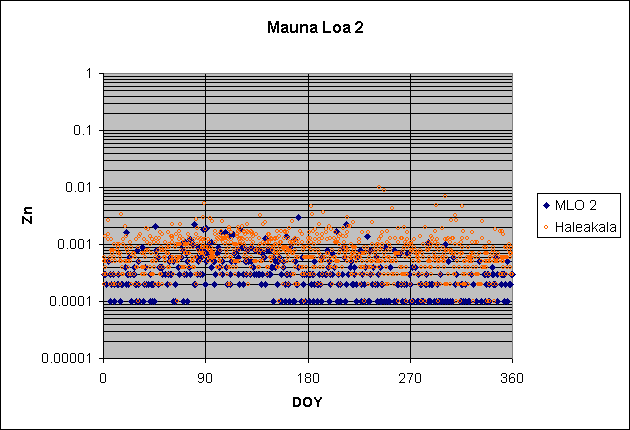
The IMPROVE data for Zn and Zn at Haleakala
This page supplements the Zn page by illustrating how the
Zn data over much of the American West display spring peaks that are consistent
with the peak at Haleakala both in timing and in concentration, but that the
peaks are not as clear as those for Pb because the background for Zn is higher
and noisier. East of the Rockies, the peak is masked very quickly by the higher
eastern background. In other words, this page presents a message that is very
similar to the corresponding page for Pb.
I chose Haleakala over Mauna Loa for the same basic reason as
for Pb—the concentrations of Zn at Haleakala during the spring peak that were closer to those in western North
America than were the lower ones at Mauna Loa. The plots for Zn at
the two places are shown below.

I will be the first to admit that the decision to use Haleakala as reference
site for Zn is arguable, for the spring peak there is broader and not much
higher than at Mauna Loa. I may revisit this question if time permits.
The rest of this page follows the format of the corresponding
Pb page. The concentrations
of Zn throughout much of the West are very similar
to those at Haleakala during winter and into spring (though at least the first
half of the spring peak). Shown below is one of the clearer examples of this,
for Scoville, Idaho.

As for Pb, the simplest explanation is that the North
American Pb of winter and spring does indeed come largely from over the Pacific. But
after the spring peak passes, the Pb falls away at Scoville (and other
western sites) less rapidly than at Haleakala (an effect that will be seen more
in more pronounced form for Si
below). That means that "local" Pb takes over in late spring, and continues to
dominate throughout the summer and fall. At the end of fall (typically in late
November or early December) the Pb at the western North American sites drops to to stable Pacific values
(with or without a preliminary fall peak) and remains there through the winter.
East of the Rockies, background concentrations of Pb rise
enough to fall well above the Pacific/Western levels and obscure the spring
peak. You can see the effect beginning by Badlands, South Dakota, particularly
during the winter:

The obscuring effect is stronger at Mammoth Cave NP, Kentucky:

and at more-easterly locations such as Shenandoah NP, Virginia:

As with Pb, there are curious indications of a short Pacific-type spring peak, or at least a narrowing of concentrations, as far to the northeast as Acadia National Park, Maine:

The north-central states do not show the spring peak for Zn that they did for Pb. A typical case is Boundary Waters, Minnesota:

Also missing is the spring peak in the Southeast that was seen for Pb. Chassahowitzka NWR, Florida, is a good example of plots for the Southeast:

In summary, Zn shows a spring peak in the West that is consistent in concentration and timing with the one at Haleakala, and so probably represents material arriving from over the Pacific Ocean. But no such peaks are seen east of the Rockies, presumably because of the higher and noisier backgrounds for Zn than for Pb. Peaks are also not seen for Arctic air entering via the north-central states and for air in the Southeast. Later we will see whether the absence of the Pacific peaks is strictly explained by the higher local backgrounds for Zn.